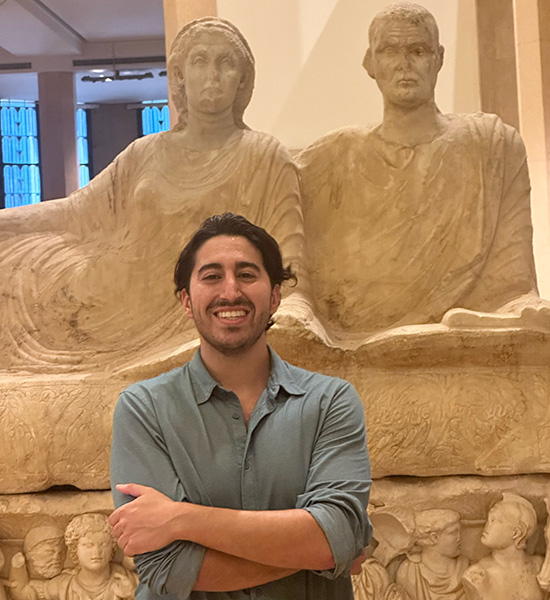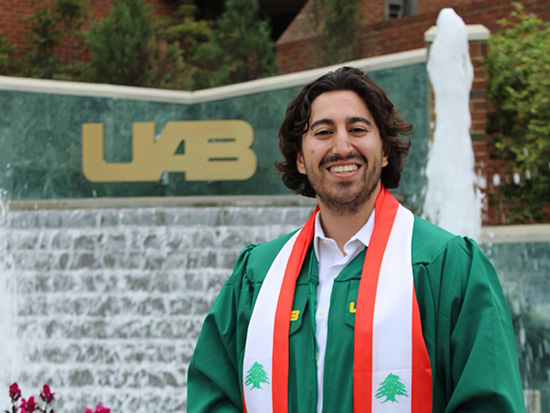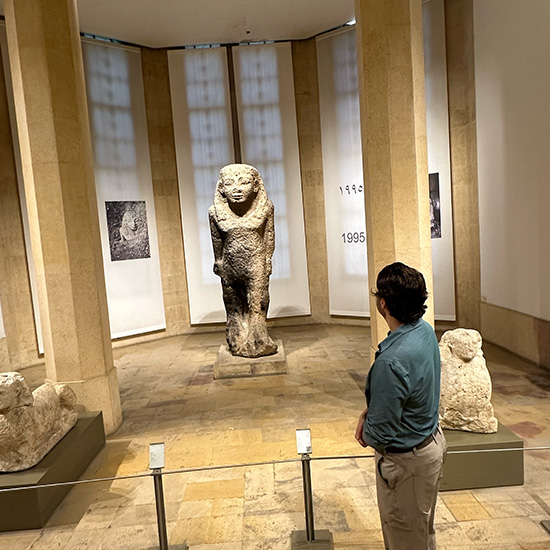 Ali Kesserwani, a computer science and anthroplogy studentAli Kesserwani’s journey at the University of Alabama Birmingham exudes cultural exploration as he integrated his love for languages by converging two worlds of languages. Kesserwani double majored in anthropology and computer science and utilized machine language to advance his learning of other world languages. He will graduate with a bachelor’s degree from the College of Arts and Sciences in the commencement ceremony for undergraduates Saturday, Aug. 10.
Ali Kesserwani, a computer science and anthroplogy studentAli Kesserwani’s journey at the University of Alabama Birmingham exudes cultural exploration as he integrated his love for languages by converging two worlds of languages. Kesserwani double majored in anthropology and computer science and utilized machine language to advance his learning of other world languages. He will graduate with a bachelor’s degree from the College of Arts and Sciences in the commencement ceremony for undergraduates Saturday, Aug. 10.
The momentum for multilingualism
Born in Dothan, Alabama, and raised in a Lebanese American, Arabic-speaking household, Kesserwani developed an interest in learning multiple languages early on. Growing up, he visited Lebanon every summer, a country with a rich archeological history, which captivated his curiosity for languages. He spoke Arabic at home and started learning French as a middle school student. As he approached high school, he furthered his Arabic skills while studying Latin and German.
“Visiting Lebanon almost every summer throughout my life has shaped the person I am today,” Kesserwani said. “It not only exposed me to various languages such as Arabic and French, but it also strengthened my love for culture and history."
He continued his language learning momentum after joining UAB as an anthropology and computer science major by learning Spanish, Biblical Hebrew, Aramaic, and grammar and hieroglyphs of Middle Egyptian.
“UAB was a natural choice for me because of its incredible variety of backgrounds and skills within the student body. Choosing UAB has been by far one of the best decisions I have ever made as I got exposure to the world while staying in Alabama. The experiences I have been able to cultivate through the variety among professors, students and opportunities have been nothing short of amazing.”
As a junior, he interned at the Reynolds Finley Historical Library –– his proudest accomplishment at UAB –– where he learned about an uncatalogued corpus of 16th to 19th century Arabic and Syriac manuscripts that needed examination and cataloguing. This experience led Kesserwani to discover that the evolution of the Arabic script from the Nabataean alphabet may have been catalyzed by Syriac influence in Arabia between the 4th and 6th centuries CE coinciding with the advent of Christianity in the region.
“I saw it as the perfect opportunity to excel in my literary skills and learn academic terminology in Arabic. During this internship, I learned basics of Syriac grammar and alphabet to understand the 16th century two-volume prayerbook better, discovering the evolution of Arabic,” Kesserwani said.
 Kesserwani will be pursuing a master's degree in computer science at Georgia Tech this Fall.
Kesserwani will be pursuing a master's degree in computer science at Georgia Tech this Fall.
Kesserwani also analyzed 2,000-year-old inscriptions and artifacts in Palmyrene Aramaic, an ancient language, as part of his research project with the University of Wisconsin.
“Researching under Dr. Jeremy Hutton has been an amazing experience because I have applied my knowledge of ancient Semitic languages in a real-world setting, and I have learned to write and research like a real archaeologist and linguist,” Kesserwani said. “I have also learned to use fascinating tools such as Reflectance Transformation Imaging, or RTI, enabling me to adjust the lighting on images of inscriptions and see shapes and letters invisible to the naked eye.”
One anthropology class, Landscape Archaeology, solidified his desire to merge technology and archaeology as he had the opportunity to identify over 30 potential archaeological sites in a 150-square-mile area in southern Lebanon using satellite imagery.
“My favorite memories at UAB are participating in cultural organizations such as being the president of the Middle Eastern Students Association, frequently going to the Pakistani Students Association events and attending many other cultural events. I met many people, made new friends and learned about cultures I had not been exposed to before.”
Promoting language learning through computer science
Throughout his language learning endeavors, Kesserwani noticed that most language-learning apps are designed for beginners, and there is a scarcity of apps for intermediate to advanced stages. Therefore, he merged his passions for computer science, anthropology and languages to create a language-learning app called Linguaberry, which has 16 available languages. His app combines all the aspects of language learning into a single software using AI, to carefully and accurately generate data in all the languages it supports.
 Kesserwani in Lebanon“Ali’s innovative approach to combining computer science with anthropology is truly inspiring,” Mahmut Unan, Ph.D., assistant professor in the Department of Computer Science, said. “His dedication to creating a comprehensive app for language learning sets him apart. We’re excited to see the impact his work will have on the future of interdisciplinary research.”
Kesserwani in Lebanon“Ali’s innovative approach to combining computer science with anthropology is truly inspiring,” Mahmut Unan, Ph.D., assistant professor in the Department of Computer Science, said. “His dedication to creating a comprehensive app for language learning sets him apart. We’re excited to see the impact his work will have on the future of interdisciplinary research.”
Kesserwani continues to feed his passion for anthropology by visiting the Roman temples and Crusader castles in the MENA region. He will be pursuing a Master of Computer Science degree at Georgia Tech in the fall of 2024 and ultimately plans to obtain a doctoral degree in anthropology.